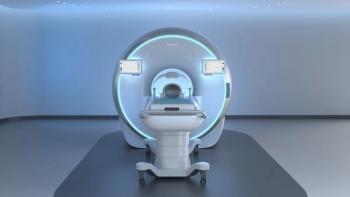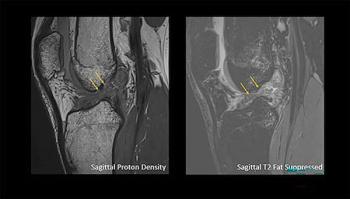
High-field open MRI scanners capture center stage at RSNA
Siemens, Fonar join GE as open units move to high-fieldThe effort to create high-field open MRI systems has shifted into high gear as three companies highlighted their versions of this new breed of products on the exhibit floor of last
Siemens, Fonar join GE as open units move to high-field
The effort to create high-field open MRI systems has shifted into high gear as three companies highlighted their versions of this new breed of products on the exhibit floor of last months RSNA meeting.
GE Medical Systems of Waukesha, WI, showcased the only commercially available product, Signa OpenSpeed, on the second floor of its booth. The system, which cleared the FDA Nov. 12, is expected to begin shipping in the second quarter of 2000 with a complement of coils and gradients that promise to support routine MR exams. In an effort to keep it from getting lost in the hustle and bustle of the RSNA show, OpenSpeed was unveiled to journalists two weeks before the meeting (SCAN 11/24/99).
Two other vendors debuted high-field open products at the RSNA meeting. Like OpenSpeed, both were designed around superconducting magnets.
Siemens Medical Systems of Iselin, NJ, showcased its new 1-tesla scanner. The as-yet-unnamed product is about 18 months from commercial launch. Fonar featured Pinnacle, described as utilizing hybrid technology that combines iron-core and superconducting magnet components.
Siemens introduction of its product was motivated at least in part by a desire to hold on to the companys worldwide base of 1-tesla Magnetom scanners, which include the 42SP, Impact, and Expert. Together, installations of these systems total more than 1200, according to Siemens. With GE executives making no secret of their intent to target this installed base for the sale of OpenSpeed, Siemens showed its work-in-progress system in part to dampen interest in the GE product, said John Pavlidis, vice president of Siemens magnetic resonance division.
Obviously, protecting our installed base is a key aspect, he said. We definitely think our system is worth the wait, because it is a no-compromise approach.
When the system emerges from Siemens R&D, it will have the clinical capabilities and technical features commonly associated with high-field MRI, according to Pavlidis. The system will feature a standard complement of coils to support, for example, exams of the head, neck, spine, knee, and body. Clinical capabilities will include diffusion- and perfusion-weighted imaging, contrast-enhanced MR angiography, and BOLD imaging.
Its not a matter of just increasing the field strength of an open system; its a matter of also having things people have come to expect from modern systems at high-field, such as panoramic array technology and a modern user interface, Pavlidis said.
The magnet combines iron and superconducting coil windings, he said. The design keeps the weight of the system down to about 13 tons, which is heavy by most superconducting standards but within siting parameters for most prospective customers. A key attribute of the system is active shielding on the top, according to Pavlidis.
Vertical bore design has much greater challenges when it comes to siting due to fringe fields, he said. With active shielding, this system can be sited in the space typically set aside for a 1.5-tesla system.
Standard on the system will be gradients with a 20-mtesla amplitude and a slew rate of 25. Engineers plan to outfit the system with the same operating specifications as those found on Siemens 1-tesla Harmony.
It will be an open high-field systemnot a higher field low-field system, said Pavlidis, alluding to Siemens belief that GEs 0.7-tesla OpenSpeed does not fit the classic definition of high-field.
The categories defining MRI scanners have blurred recently. In the late 1980s, mid-field was populated mostly by systems ranging between 0.35- and 0.5-tesla. This category extended to include the 0.2-tesla scanner with the explosive popularity of open systems from 1995 to the present. Sales of 0.5-tesla products have since dried up, as most of these scanners are closed or cylindrical products, which have little customer appeal. The shift downward in the definition of mid-field raised the possibility of a downward adjustment in the definition of high-field, which GE has chosen.
Fonars Pinnacle will also likely fall in the lower range of this still-evolving definition of high-field. The prototype of this system, now running in the companys engineering lab in Melville, NY, operates at 0.6-tesla. The company hopes to bootstrap its technology to increasingly powerful field strengths until production models are configured to run at 0.8- or 1-tesla, according to Anthony Giambalvo, Fonar business development manager.
We started at 0.6-tesla because were familiar with that field strength and with the RF technology that goes with it, Giambalvo said.
Fonars flagship product, the Quad 12000, operates at this field strength using a resistive magnet.
The companys first commercial MRI scanners, released nearly two decades ago, were built around permanent magnets. As yet, a Fonar superconducting system has neither been commercially released nor has one been displayed. Rather than show a mock-up of the system on the RSNA floor, the company showed pictures of the system and images reportedly generated by the prototype.
Were interested in going to a higher field with the open concept, which we invented, so we started working with a superconducting magnet, Giambalvo said. Its nearly identical to the iron magnet frame we now use, but we replace the source of the magnetic field with a superconducting coil.
The stronger field generated by this magnet presents some novel challenges to the company, he said. Among them is the delicate nature of superconducting coils, compared to the robust permanent and resistive magnets with which company engineers have worked in the past. Coil design will be different as well, Giambalvo said.
Pinnacle could be on the market by the third quarter of 2000, according to Fonar. If the company meets that timeline, the system will be available just a few months after production models of OpenSpeed begin rolling off the GE assembly line and about half a year before Siemens is expected to begin selling its commercial 1-tesla open system.
Newsletter
Stay at the forefront of radiology with the Diagnostic Imaging newsletter, delivering the latest news, clinical insights, and imaging advancements for today’s radiologists.




























